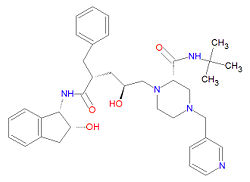Indinavir: Difference between revisions
imported>David E. Volk (New page: {{subpages}} right|thumb|250px|{{#ifexist:Template:Indinavir structure.jpg/credit|{{Indinavir structure.jpg/credit}}<br/>|}}Indinavir '''Indinavir''', a...) |
imported>David E. Volk (drug interactions partly finished) |
||
| Line 5: | Line 5: | ||
Its IUPAC chemical name is (2S)-N-tert-butyl-1-[(2S,4R)-2-hydroxy-5-[[(1S,2R)-2-hydroxy-2,3-dihydro-1H-inden-1-yl]amino]-5-oxo-4-(phenylmethyl)pentyl]-4-(pyridin-3-ylmethyl)piperazine-2-carboxamide and it has chemical formula C<sub>36</sub>H<sub>47</sub>N<sub>5</sub>O<sub>4</sub>. | Its IUPAC chemical name is (2S)-N-tert-butyl-1-[(2S,4R)-2-hydroxy-5-[[(1S,2R)-2-hydroxy-2,3-dihydro-1H-inden-1-yl]amino]-5-oxo-4-(phenylmethyl)pentyl]-4-(pyridin-3-ylmethyl)piperazine-2-carboxamide and it has chemical formula C<sub>36</sub>H<sub>47</sub>N<sub>5</sub>O<sub>4</sub>. | ||
== Drug interactions == | |||
The absorption of indinavir is decreased by St. John's Wort, antacids, such as [[aluminum]], [[bismuth]], [[calcium]], [[magnesium]] and [[magnesium oxide]], by [[omeprazole]] and related compounds ([[esomeprazole]], [[lansoprazole]], [[pantoprazole]] and [[rabeprazole]]) and by [[Rifampin]] and its derivitive [[Rifabutin]]. | |||
Indinavir increases the anticoagulant effect of [[anisindione]], [[acenocoumarol]], [[dicumarol]], and [[warfarin]] and also increases the effect of [[benzodiazepine]]. Benzodiazepine related drugs include [[Alprazolam]], [[Chlordiazepoxide]], [[Clonazepam]], [[Clorazepate]], [[Diazepam]], [[Estazolam]], [[Flurazepam]], [[Halazepam]], [[Midazolam]], [[Prazepam]], [[Quazepam]] and [[Triazolam]]. | |||
Vardenafil The protease inhibitor increases the effect and toxicity of vardenafil | |||
Cyclosporine The protease inhibitor increases the effect of cyclosporine | |||
Fentanyl The protease inhibitor increases the effect and toxicity of fentanyl | |||
Pimozide The protease inhibitor increases the effect and toxicity of pimozide | |||
Sildenafil The protease inhibitor increases the effect and toxicity of sildenafil | |||
Vitamin C Vitamin C decreases indinavir levels | |||
Trazodone This strong CYP3A4 inhibitor increases the effect and toxicity of trazodone | |||
Terfenadine Increased risk of cardiotoxicity and arrhythmias | |||
Astemizole Increased risk of cardiotoxicity and arrhythmias | |||
Cisapride Increased risk of cardiotoxicity and arrhythmias | |||
Delavirdine Delavirdine increases the effect of indinavir | |||
Clarithromycin Clarithromycin increases the effect and toxicity of indinavir | |||
Carbamazepine Indinavir increases the effect and toxicity of carbamazepine | |||
Atorvastatin Increases the effect and toxicity of atorvastatin | |||
Amiodarone Indinavir increases the effect and toxicity of amiodarone | |||
Efavirenz Efavirenz decreases the effect of indinavir | |||
Erlotinib This CYP3A4 inhibitor increases levels/toxicity of erlotinib | |||
Fusidic Acid Increases the effect and toxicity of fusidic acid | |||
Ketoconazole Ketoconazole increases the efefct of indinavir | |||
Ranolazine Increased levels of ranolazine - risk of toxicity | |||
Sunitinib Possible increase in sunitinib levels | |||
Tacrolimus Increases the effect and toxicity of tacrolimus | |||
Saquinavir Possible antagonism of action | |||
Risperidone Increased risk of extrapyramidal symptoms | |||
Quinupristin This combination presents an increased risk of toxicity | |||
Atazanavir Increased risk of hyperbilirubinemia with this association | |||
Ergotamine Increases the effect and toxicity of the ergot derivative | |||
Dihydroergotamine Increases the effect and toxicity of the ergot derivative | |||
== External Links == | == External Links == | ||
{{DailyMed}} | {{DailyMed}} | ||
Drug Bank at http://www.drugbank.ca/cgi-bin/getCard.cgi?CARD=DB00224.txt | Drug Bank at http://www.drugbank.ca/cgi-bin/getCard.cgi?CARD=DB00224.txt | ||
Revision as of 11:46, 29 January 2008
Indinavir, also called indinavir sulfate or Compound J and sold under the trade name Crixivan®, is a protease inhibitor used to treat HIV/AIDS. The HIV-1 protease in required to cleave the viral gag-pol polyprotein into individual functional proteins to make an infectious mature viral particle. Indinavir binds to the HIV-1 protease, inhibiting its function and stopping the production of infectious viral particles. Protease inhibitors are usually used with two or more other anti-HIV medications. Symptoms of overdose include heart attack and chest pain.
Its IUPAC chemical name is (2S)-N-tert-butyl-1-[(2S,4R)-2-hydroxy-5-[[(1S,2R)-2-hydroxy-2,3-dihydro-1H-inden-1-yl]amino]-5-oxo-4-(phenylmethyl)pentyl]-4-(pyridin-3-ylmethyl)piperazine-2-carboxamide and it has chemical formula C36H47N5O4.
Drug interactions
The absorption of indinavir is decreased by St. John's Wort, antacids, such as aluminum, bismuth, calcium, magnesium and magnesium oxide, by omeprazole and related compounds (esomeprazole, lansoprazole, pantoprazole and rabeprazole) and by Rifampin and its derivitive Rifabutin.
Indinavir increases the anticoagulant effect of anisindione, acenocoumarol, dicumarol, and warfarin and also increases the effect of benzodiazepine. Benzodiazepine related drugs include Alprazolam, Chlordiazepoxide, Clonazepam, Clorazepate, Diazepam, Estazolam, Flurazepam, Halazepam, Midazolam, Prazepam, Quazepam and Triazolam.
Vardenafil The protease inhibitor increases the effect and toxicity of vardenafil Cyclosporine The protease inhibitor increases the effect of cyclosporine Fentanyl The protease inhibitor increases the effect and toxicity of fentanyl Pimozide The protease inhibitor increases the effect and toxicity of pimozide Sildenafil The protease inhibitor increases the effect and toxicity of sildenafil Vitamin C Vitamin C decreases indinavir levels Trazodone This strong CYP3A4 inhibitor increases the effect and toxicity of trazodone Terfenadine Increased risk of cardiotoxicity and arrhythmias Astemizole Increased risk of cardiotoxicity and arrhythmias Cisapride Increased risk of cardiotoxicity and arrhythmias Delavirdine Delavirdine increases the effect of indinavir Clarithromycin Clarithromycin increases the effect and toxicity of indinavir Carbamazepine Indinavir increases the effect and toxicity of carbamazepine Atorvastatin Increases the effect and toxicity of atorvastatin Amiodarone Indinavir increases the effect and toxicity of amiodarone Efavirenz Efavirenz decreases the effect of indinavir Erlotinib This CYP3A4 inhibitor increases levels/toxicity of erlotinib
Fusidic Acid Increases the effect and toxicity of fusidic acid Ketoconazole Ketoconazole increases the efefct of indinavir Ranolazine Increased levels of ranolazine - risk of toxicity Sunitinib Possible increase in sunitinib levels Tacrolimus Increases the effect and toxicity of tacrolimus Saquinavir Possible antagonism of action Risperidone Increased risk of extrapyramidal symptoms Quinupristin This combination presents an increased risk of toxicity
Atazanavir Increased risk of hyperbilirubinemia with this association Ergotamine Increases the effect and toxicity of the ergot derivative Dihydroergotamine Increases the effect and toxicity of the ergot derivative
External Links
Indinavir - FDA approved drug information (drug label) from DailyMed (U.S. National Library of Medicine). Drug Bank at http://www.drugbank.ca/cgi-bin/getCard.cgi?CARD=DB00224.txt
